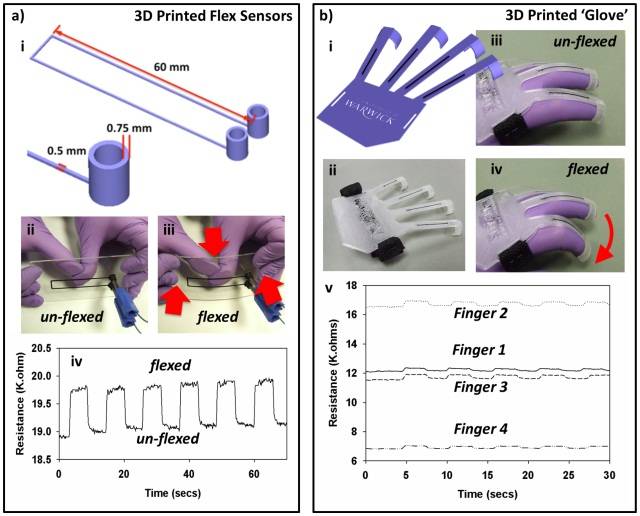This article is more than 1 year old
British boffins 3D print electrical sensors
Piezoresistive polymer means 3D printers could spit out working game controllers
Researchers at the University of Warwick and GKN Aerospace have developed a material that, when used in a 3D printer (3DP), makes it possible for the printed objects to include working sensors.
Detailed in a paper titled A Simple, Low-Cost Conductive Composite Material for 3D Printing of Electronic Sensors (PDF), the researchers explain that objects printed by 3D printers are a grand way to make sure CAD work is progressing well, but also disappointingly inanimate and unready for integration with other components.
That makes 3DP printers useful for basic prototyping, but the researchers say they aspire to “meet the demands of entrepreneurs, designers and artists wishing to create ever more complex and high-tech products using 3DP technology”. Those types, the paper say, want to “move towards the incorporation of functional elements such as electronic sensors into 3D printed macroscale structures.”
The team says they’ve made that possible by developing a new material, which they dub ‘carbomorph’, that can do just that.
Carbomorph is based on Carbon Black filler, a product the paper says is an “amorphous form of carbon, produced from the incomplete combustion of heavy petroleum products” and which is “readily available and inexpensive”. Carbon Black is also conductive.
The team also got its hands on a “readily available modeling plastic” called “polymorph” and combined it with Carbon Black until they had a substance that was able to be 3D printed and still conducted electricity.
Better yet, the new material was also piezoresistive – its electrical resistance changes when squeezed.
To test that property, the team used “a triple-head BFB3000 purchased from Bits from Bytes Ltd” to create a track of carbomoprh, hooked it up to sensors feeding into an “arduino electronics prototyping platform for data capture through a potential divider to measure resistance.” When the track was flexed, the rig detected a change in its resistance.
That’s mighty handy because carbomorph is so plastic it can be formed into many shapes, allowing slots for sensors to be built in to products made from the material.
The paper goes on to describe a similar experiment with multiple carbomorph strips used to construct an “exo-glove” capable of detecting fingers flexing, and capacitive buttons.
The University’s announcement of the research even shows a gaming controller made of carbomorph, complete with working buttons awaiting only a tap from users’ fingers to send a signal into whatever electronics will turn the change of resistance into on-screen action.

3D printing of flex sensors. ai) the CAD design of flex sensor, aii) the printed flex sensor, aiii) the printed sensor
undergoing flexing,aiv) the resistance response of the sensor during flexing, bi) CAD design of the 3D printed ‘glove’,
bii) the printed ‘glove’,biii) the printed ‘glove’ before flexing, biv) the printed ‘glove’ during flexing and
bv) the resistance response of each finger during 5 flexings.
The paper concludes by saying the scientists think they’re on to something.
“The formulated material has enabled the rapid production of a range of functional electronic sensors using a simple, low-cost 3D printer. The sensors range from piezoresistive sensors able to sense mechanical flexing when either placed on an existing object or embedded inside a printed object, through to capacitive sensors printed as part of custom interface device or embedded inside a ‘smart’ vessel able to sense the presence and quantity of liquid inside.”
As ever, there’s a long way to go before one can nip down to a shop, bring home some carbomorph and print out anything useful, not least because the substance is tricky to work with.
Indeed, the first experiment detailed noted that the printed carbomorph track was wider than anticipated, “due to spreading resultant from the lower melt viscosity of the carbomorph compared to the standard printing materials.” ®
